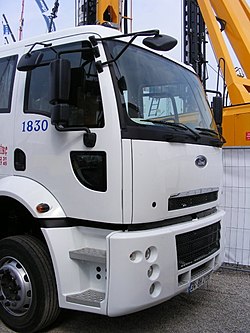Ford Cargo
| ford | |
|---|---|
| Cargo | |
| Manufacturer: | ford |
| Sales designation: | Cargo |
| Production period: | since 1981 |
| Previous model: | Ford D series |
| Successor: |
Ford LCF (North America since 2004) Iveco Eurocargo (Western Europe since 1992) |
| Technical specifications | |
| Engines: | diesel |
| Power: | 63-110 kW |
| Perm. Total weight: | 7-15 t |
The Ford Cargo is a truck made by Ford that was offered on the European market between 1981 and 1992 . In Asia , Oceania and Venezuela , the model is known as the Ford Trader . There, as in South America , further developed models of the Ford Cargo are still offered today. The Cargo is also produced by Otosan in Turkey and in addition to the Asian and oceanic markets, models are also exported to the Middle East and Eastern Europe .
Europe
The cargo was developed in English Dunton in the then-new Ford design center for commercial vehicles as mild to moderate duty trucks for distribution transport, the Ford D-Series / Ford N-Series and the lighter Ford A-Series replace, the the Ford Transit had already approached. Since its introduction in 1981 it has been produced for Europe in Langley ( Berkshire ), UK .
He was a completely new design as a forward control with under the cab stationary diesel engine . The driver's cab had a modern design, was relatively angular and had a steeply rising vehicle front with a windshield that was only slightly inclined to the rear. In addition to a normal side window, the doors had an additional front window, which was pulled down on both sides to the belt line above the fenders for a better view of smaller road users next to the vehicle. An angular, recumbent headlight and indicators on each side were mounted above the bumper next to the radiator grille, which was mostly made of matt black plastic . The driver's cab was in local and long-distance version based on the American design of the time and the style of the predecessor of the N series and was not carried out in the full vehicle width. Only the fenders covered the full width of the vehicle.
Light versions
The gross vehicle weight was between 6 and 15 t when it was launched, with mainly models in the 7.5 t class and up to 9 tonnes being sold. Water -cooled Ford diesel engines between 63 and 110 kW (85 and 150 hp) were available for the drive . The engines with 63 to 88 kW (85 to 120 hp) were reserved for vehicles with a gross vehicle weight of 7 and 8 tons. For the smallest model there was only the smallest machine
Heavy executions
With the foreseeable cessation of production of the unsuccessful Ford Transcontinental heavy long-distance truck , variants of the Cargo for heavy long-distance use were also offered from 1982. Despite the larger chassis, the relatively narrow cab remained. There were air-cooled V6 diesel engines from Klockner-Humboldt-Deutz 170 to 204 hp, as well as water-cooled six-cylinder engines from Cummins with up to 280 hp. Designed from the start for regional transport, its equipment was not very suitable for long-distance transport and was therefore inferior to its competitors.
Marketing and end of production
In the market segment of light distribution trucks, Cargo , which was voted Truck of the Year in Great Britain in 1982, was for a time the market leader in Great Britain and also achieved respectable success in Germany. The biggest drawback was the very thin network of dealers and workshops on the continent. Only a few Ford dealers were willing to build or maintain sales and, above all, workshop capacities for a marginal product in their range.
As early as 1985, production in Langley had been transferred to a joint venture between Ford and its competitor Iveco . After around 140,000 units had been manufactured, production there ended on December 22nd, 1992. After that, Ford Europe withdrew entirely from the heavy and medium-duty commercial vehicle business. The Cargo was followed by the Iveco Eurocargo , its rare heavy variants of the Iveco EuroTech . In the British Isles, they therefore also carried the Ford brand logo on the front of the vehicle for a transitional period.
Derivatives worldwide
The Cargo is a "world vehicle" and some of its offshoots are or were built in various countries. It is still offered in a revised version in South America , as a trader in Venezuela . In the North American market, the vehicle was also sold as Freightliner Cargo and Sterling Cargo, and was replaced by the Ford LCF in 2004 .
In India it is produced by the manufacturer Ashok Leyland as Ecomet, and in Sri Lanka near Lanka Ashok Leyland.
In Turkey , the Ford Cargo is built by Otosan . Since 2012 there has been a completely revised model series, which also includes heavy long-distance models and is exported to the Middle East and Eastern Europe. As a Ford Trader, you export it to Oceania and Asia.
Panhard built a military version of the Cargo as the Panhard TC54.
See also
literature
- Werner Oswald : trucks, delivery vans, transporters 1945-1988 . Motorbuch-Verlag, 2nd edition, Stuttgart 1993, ISBN 3-613-01197-2 .
Web links
- Pictures and information about Ford trucks from Olaf Nordsieck






